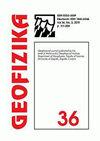Prediction of bimodal monsoonal rainfall in the central dry zone of Myanmar using teleconnections with global sea surface temperatures
IF 1.1
4区 地球科学
Q4 GEOCHEMISTRY & GEOPHYSICS
引用次数: 1
Abstract
In the central dry zone of Myanmar, the mean annual rainfall is less than 1000 mm. Although rainfed agriculture is commonly practiced there, the feasibility of rainfed farming is compromised by the large fluctuations of rainfall and the frequent occurrence of dry years. The monthly distribution of rainfall follows a bimodal pattern. The intensity of the monsoonal rainfall from May to October is characterized by two peaks, an early peak (May-June) and a late peak (August–October), separated by the inter-monsoon (July). The return times of dry and wet years make management of rainfed agriculture problematic. There is very little correlation between the early and late monsoonal rainfall (r=–0.257). However, monsoonal rainfall is teleconnected to sea surface temperatures (SSTs) in certain areas of the Pacific Ocean in real time. Furthermore, at lag times of 6–9 months, there are teleconnections between the early monsoonal, inter-monsoonal, and late monsoonal rainfall and SSTs in certain areas of the Indian Ocean and Atlantic Ocean. We used an Elman artificial neural network model to predict early monsoonal, inter-monsoonal, and late monsoonal rainfall based on teleconnections with SSTs in the Indian and Atlantic oceans 6–9 months before the rainfall occurred. The correlation coefficient between the predicted and observed rainfall exceeded 0.7 in all three cases.利用与全球海面温度的遥相关预测缅甸中部干旱区的双峰季风降雨量
在缅甸中部干旱区,年平均降雨量小于1000毫米。尽管那里普遍实行雨养农业,但由于降雨量波动大和干旱年份频繁发生,雨养农业的可行性受到影响。降雨量的月分布呈双峰型。5月至10月的季风降雨强度有两个峰值,一个是早峰值(5月至6月),另一个是晚峰值(8月至10月份),被季风间(7月)隔开。干旱和潮湿年份的回归时间使雨水灌溉农业的管理成为问题。早期和晚期季风降雨之间的相关性很小(r=-0.257)。然而,在太平洋的某些地区,季风降雨与海面温度(SST)实时遥相关。此外,在6-9个月的滞后时间,印度洋和大西洋某些地区的早季风、季风间和晚季风降雨量与SST之间存在遥相关。我们使用Elman人工神经网络模型,基于降雨发生前6-9个月印度洋和大西洋海温的遥相关,预测了早期季风、季风间和后期季风降雨。在所有三种情况下,预测降雨量和观测降雨量之间的相关系数均超过0.7。
本文章由计算机程序翻译,如有差异,请以英文原文为准。
求助全文
约1分钟内获得全文
求助全文
来源期刊

Geofizika
地学-地球化学与地球物理
CiteScore
1.60
自引率
0.00%
发文量
17
审稿时长
>12 weeks
期刊介绍:
The Geofizika journal succeeds the Papers series (Radovi), which has been published since 1923 at the Geophysical Institute in Zagreb (current the Department of Geophysics, Faculty of Science, University of Zagreb).
Geofizika publishes contributions dealing with physics of the atmosphere, the sea and the Earth''s interior.
 求助内容:
求助内容: 应助结果提醒方式:
应助结果提醒方式:


